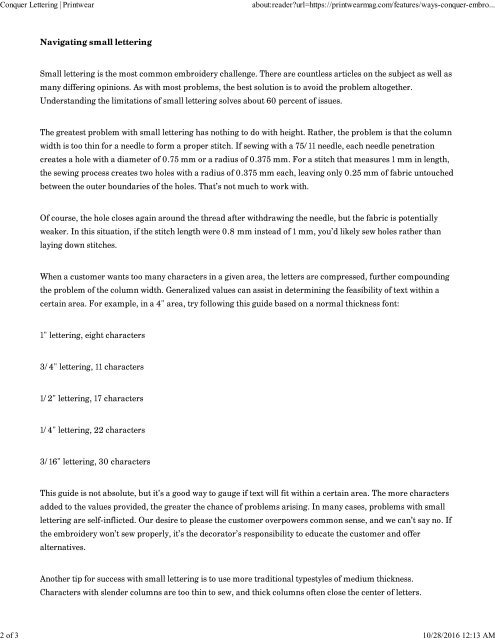Compiled Embroidery Skill Articles
You also want an ePaper? Increase the reach of your titles
YUMPU automatically turns print PDFs into web optimized ePapers that Google loves.
Conquer Lettering | Printwear<br />
about:reader?url=https://printwearmag.com/features/ways-conquer-embro...<br />
2 of 3 10/28/2016 12:13 AM<br />
Navigating small lettering<br />
Small lettering is the most common embroidery challenge. There are countless articles on the subject as well as<br />
many differing opinions. As with most problems, the best solution is to avoid the problem altogether.<br />
Understanding the limitations of small lettering solves about 60 percent of issues.<br />
The greatest problem with small lettering has nothing to do with height. Rather, the problem is that the column<br />
width is too thin for a needle to form a proper stitch. If sewing with a 75/11 needle, each needle penetration<br />
creates a hole with a diameter of 0.75 mm or a radius of 0.375 mm. For a stitch that measures 1 mm in length,<br />
the sewing process creates two holes with a radius of 0.375 mm each, leaving only 0.25 mm of fabric untouched<br />
between the outer boundaries of the holes. That’s not much to work with.<br />
Of course, the hole closes again around the thread after withdrawing the needle, but the fabric is potentially<br />
weaker. In this situation, if the stitch length were 0.8 mm instead of 1 mm, you’d likely sew holes rather than<br />
laying down stitches.<br />
When a customer wants too many characters in a given area, the letters are compressed, further compounding<br />
the problem of the column width. Generalized values can assist in determining the feasibility of text within a<br />
certain area. For example, in a 4" area, try following this guide based on a normal thickness font:<br />
1" lettering, eight characters<br />
3/4" lettering, 11 characters<br />
1/2" lettering, 17 characters<br />
1/4" lettering, 22 characters<br />
3/16" lettering, 30 characters<br />
This guide is not absolute, but it’s a good way to gauge if text will fit within a certain area. The more characters<br />
added to the values provided, the greater the chance of problems arising. In many cases, problems with small<br />
lettering are self-inflicted. Our desire to please the customer overpowers common sense, and we can’t say no. If<br />
the embroidery won’t sew properly, it’s the decorator’s responsibility to educate the customer and offer<br />
alternatives.<br />
Another tip for success with small lettering is to use more traditional typestyles of medium thickness.<br />
Characters with slender columns are too thin to sew, and thick columns often close the center of letters.




